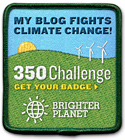
Rising temperatures are no joke: 225 Americans died in the 2006 heat wave, including 140 in New York City. Out West, the number of severe heat days in Los Angeles is expected to rise from the current 12 to between 44 and 100 over this century, according to the Intergovernmental Panel on Climate Change. Ironically, the hotter it gets, the more greenhouse gases are released from power plants as they pump out energy for our cranked-up air conditioners. And cooling accounts for nearly half the energy used by the average home during the summer, reports the EPA's Energy Star program. Smart home design, rather than chilling the air, is the better way to escape the heat.
Build for Comfort
"We build our houses for curb appeal or for the view, not thinking that all that glazing facing south in the summer is going to cook the inside of the house," says Doron Amiran, development director of the non-profit Solar Living Institute. Passive design uses the windows, walls, floors and roof to reflect and distribute environmental heat.
"A lot of people are familiar with passive solar design in cold climates and think you can do the opposite in hot climates, but that's not true," explains Daniel Aiello, a principal of Janus II Environmental Architects & Planners who designs Southwestern desert homes that require little air-conditioning. Instead, Aiello helps home and building owners eliminate harsh extremes between inside and outside spaces by setting up lightly filtered areas, typically through plantings, which become more dense and provide more shade—and consequently more cool air—the closer they are to the building. That's important, because 35 percent of a building's heat gain stems from the direct action of solar rays striking the surface, Aiello says.
Aiello also recommends light-colored and textured exterior surfaces, inset windows, overhangs or awnings over south-facing windows to block hot sunlight and vertical shading from screens, shrubs or trellises over west- and east-facing windows.
"I get customers attuned to what's going on in the environment they're in," says Aiello, adding, "Each side of the building is going to look different."
Indoors, let in air by cross ventilating, and install vents that allow hot air to escape from high spaces and cool air to enter at low spaces. Seal and caulk walls and windows to prevent cold-air leaks, and add low-emittance (low-E) glazing to reduce heat transfer.
Pump Up the Cool
Conventional AC requires a lot of energy, which produces greenhouse gas emissions, and it contains fluorocarbon-based refrigerants, which damage the ozone layer while also contributing to global warming. The most efficient option is to use portable floor fans or install ceiling fans, which consume 90 percent less energy than air-conditioning and make rooms feel seven to ten degrees cooler.
While whole house fans blow hot air from throughout the house outside, they provide substantial relief only at night and only in low humidity. However, a simpler attic fan can save up to 10 percent on AC costs. Evaporative coolers draw air over wet pads, with the resulting evaporation cooling the air. Half the price of conventional AC and consuming 75 percent less energy, these coolers can reduce indoor temperature by almost 30 degrees in hot, arid conditions (because they raise humidity indoors, they only work in dry climates).
If you must have an electric air conditioner, look for an energy-efficient Energy Star-rated model, with an Energy Efficiency Ratio (EER) above 10. The EER is the ratio of the cooling output divided by the unit's power consumption and is common on window units; look for the Seasonal Energy Efficiency Ratio (SEER) on whole-house units. Also, ask for a unit that will deal effectively with your local humidity levels. To improve indoor air quality, add a reusable electrostatic filter and wash it monthly to optimize your system's efficiency. Save energy by installing a programmable thermostat and set it to 78 degrees F.
PRODUCTS
Fans
EPA's Energy Star-rated ceiling fan/light combination units save $15 to $20 per year on utility bills: Westinghouse Silverdale ES ($199; http://www.westinghouseceilingfans.com/, 800-999-2226); Hunter Sonora ($132 and up; http://www.hunterfan.com/, 888-830-1326).
Room Air Conditioners
Consumer Reports recommends these Energy Star-rated models: Friedrich SS10L10-A ($700, EER: 12; http://www.friedrich.com/, 800-541-6645); GE AGM06LH ($180, EER: 10.7) and AGM08LH ($240, EER: 10.8; http://www.ge.com/, 800-626-2005); Frigidaire FAA067P7 ($150, EER: 10.7) and FAA087P7 ($180, EER: 10.8; http://www.frigidaire.com/, 800-374-4432).
Central Air
The American Council for an Energy-Efficient Economy recommends the Lennox HSXA19 Series (SEER: 14.6 to 17.5; http://www.lennox.com/, 800-9-LENNOX), American Standard Allegiance 18 (SEER: 16.5 to 18.3; http://www.americanstandardair.com/) and Trane XL19i (SEER: 15.5 to 17; http://www.trane.com/Default.asp).
Unlike other evaporative coolers, the Coolerado doesn't add humidity to indoor air because the evaporative process happens behind a heat exchanger ($4,125 and up, EER: 40; http://www.coolerado.com/, 303-375-0878).
For more, see the Air Conditioner Product Report at http://www.thegreenguide.com/products/.
Sunday, June 1, 2008
Green-Livin Keep Your Cool with Less AC
Subscribe to:
Post Comments (Atom)


No comments:
Post a Comment